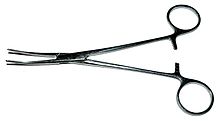Arterial clamp
An artery clamp , also known as a hemostasis , is a medical instrument for briefly grasping and holding severed blood vessels , for primary hemostasis or before the intended ligature , for example during an operation .
At first glance, the clamps have a certain resemblance to surgical scissors and are held like these, but instead of cutting surfaces have two transversely grooved jaws with a detent. They are usually made of stainless steel.
There are a variety of modifications or further developments of the artery clamps, which are often named after their inventor or developer, such as
- the Kocher clamp (sharp and straight or slightly curved, toothed at the end of the blade) after Emil Theodor Kocher ,
- the Péan clamp (blunt and corrugated at the end of the blade) after Jules Émile Péan
- the Halsted clamp according to William Stewart Halsted (straight or curved, without teeth, also called mosquito clamp ) or
- the Mikulicz clamp after Johann von Mikulicz .
- the "rescue clamp". This is a Péan clamp that has a ring and a hook instead of the two rings on the handle. The hook is used to hang up infusion bags or bottles, which can be attached with the clamp above the patient. Conversely, things that cannot be hung up easily (e.g. on a ring, a rod, etc.) can be grasped with the clamp and the hook used as a "hanger".
There are also arterial clamps that are named according to the type of application, such as abdominal clamp or intestinal clamp .
The cloth clamp, which is used to attach surgical drapes to the patient, is not one of the artery clamps .
literature
- The big Reuter: Springer universal dictionary medicine, pharmacology and dentistry. Volume 1. ISBN 3-540-25104-9 .
- Katja Nuß: Veterinary instruments. Schattauer Verlag, 1998. ISBN 3-7945-1794-6 . Pp. 23-31.


